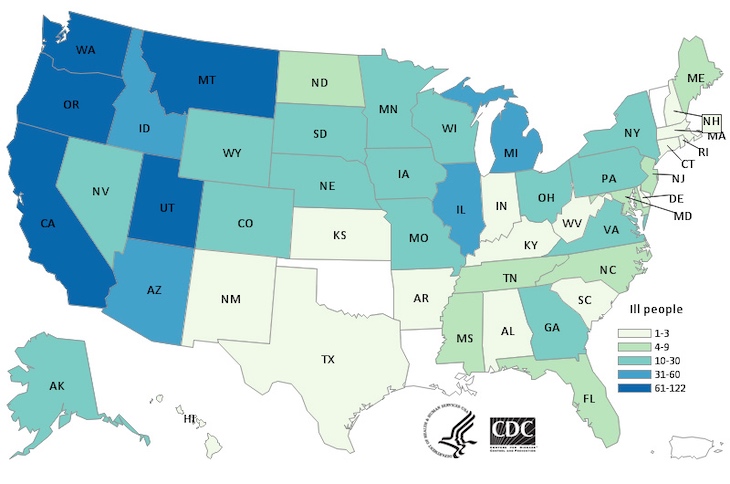The Thomson International onion Salmonella Newport outbreak has now sickened at least 1,012 people in 47 states, according to a September 1, 2020 update by the Centers for Disease Control and Prevention (CDC). That is an increase of 143 more ill persons in the last two weeks. One hundred thirty-six people are hospitalized.

The case count by state is: Alaska (21), Alabama (1), Arizona (35), Arkansas (2), California (122), Colorado (26), Connecticut (2), Delaware (2), Florida (8), Georgia (11), Hawaii (3), Idaho (37), Illinois (54), Indiana (3), Iowa (26), Kansas (2), Kentucky (1), Maine (6), Maryland (7), Massachusetts (2), Michigan (47), Minnesota (18), Mississippi (4), Missouri (11), Montana (63), Nebraska (10), Nebraska (10), Nevada (11), New Hampshire (1), New Jersey (8), New Mexico (1), New York (10), North Carolina (6), North Dakota (9), Ohio (11), Oregon (101), Pennsylvania (22), Rhode Island (3), South Carolina (1), South Dakota (23), Tennessee (7), Texas (2), Utah (110), Virginia (10), Washington (117), West Virginia (2), Wisconsin (10), and Wyoming (23).
Illness onset dates range from June 19, 2020 to August 11, 2020. The patient age range is from less than 1 to 102 years. Of 581 people who gave information about their condition to government officials, 136 were hospitalized.
Epidemiologic and traceback evidence indicates that onions supplied by Thomson International is linked to this outbreak. The company has recalled onions and products made with onions. Red, white, yellow, and sweet yellow onions have been recalled. They have been sold at several grocery store Cains, including Food Lion, Kroger, Publix, Walmart, Ralph’s, andTrader Joe’s.
Look at the list of recalled onions and recalled products made with those onions carefully, and discard any you may have in your home. If you aren’t sure if the onions or onion products in your home are from Thomson International, discard them, even if part have been eaten and no one has gotten sick. Then sanitizer your fridge and pantry and any surfaces that may have come into contact with onions and their packaging, such as storage bins, knives, cutting boards, utensils and countertops.
In interviews, ill persons answered questions about the foods they ate before they got sick. Ninety percent of patients said they ate onions or foods containing onions before they got sick. Most ate red onions, about 60% ate white onions, and 56% ate yellow onions. Most patients said they ate more than one type of onion.
Thirty-four illness clusters, or a group of two more more unrelated people who ate at the same restaurant or shopped at the same store before illness onset, have been identified. Investigations by the states and the FDA found that 23 of the 34 clusters were linked to restaurants or grocery stores. All 23 served or sold red, yellow, or white onions.
Noted food safety lawyer Fred Pritzker, who has represented many clients in Salmonella lawsuits against stores and restaurants, said, “Many people wouldn’t think that onions could be contaminated with enough bacteria to make you sick. But unfortunately produce is a common vehicle for these multistate outbreaks.”
There is another Salmonella Newport onion outbreak in Canada that is also linked to Thomson International onions imported from the United States. In that country, 457 people are sick in 7 provinces. Genetic evidence suggests that those sickened in the U.S. and in Canada share a common source of infection.
Symptoms of a Salmonella infection can include a fever, a headache, nausea, stomach cramps, vomiting, abdominal cramps, and diarrhea that may be bloody. Symptoms usually start 6 hours to 6 days after infection. Even after complete recovery, patients may develop long term health problems such as reactive arthritis, endocarditis, and high blood pressure.
If you or someone you know has been sickened with these symptoms, especially after eating onions, see your doctor. You may be part of this onion Salmonella Newport outbreak.

If you or a loved one have been sickened with a Salmonella Newport infection after eating recalled onions or onion products, please contact our experienced attorneys for help at 1-888-377-8900 or 612-338-0202.




